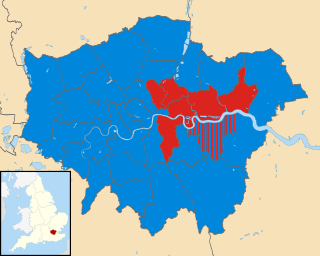Related Research Articles

The first election to the Greater London Council (GLC) was held on 9 April 1964.

The second election to the Greater London Council was held on 13 April 1967, and saw the first Conservative victory for a London-wide authority since 1931.

The third election to the Greater London Council was held on 9 April 1970 and saw a Conservative victory with a reduced majority.

The fourth election to the Greater London Council was held on 12 April 1973. Labour won a large majority of 58 seats to 32 for the Conservatives; the Liberals also won their first two seats on the council.

Westminster City Council is the local authority for the City of Westminster in Greater London, England. The city is divided into 20 wards, each electing three councillors. The council is currently composed of 31 Labour Party members and 23 Conservative Party members. The council was created by the London Government Act 1963 and replaced three local authorities: Paddington Metropolitan Borough Council, St Marylebone Metropolitan Borough Council and Westminster Borough Council.

Cities of London and Westminster is a constituency returning a single Member of Parliament (MP) to the House of Commons in the United Kingdom Parliament. It is a borough constituency for the purposes of election expenses and type of returning officer. As with all constituencies, the election is decided using the first past the post system of election. Since its creation at the 1950 general election, the constituency has always elected the candidate nominated by the Conservative Party.

The region of Greater London, including the City of London, is divided into 73 parliamentary constituencies which are sub-classified as borough constituencies, affecting the type of electoral officer and level of expenses permitted.

Blackley and Broughton is a constituency represented in the House of Commons of the UK Parliament by Graham Stringer. He was first elected in 1997 for the former Manchester Blackley and prior to this was Leader of Manchester City Council. The constituency covers north Manchester and east Salford.
Paddington was a parliamentary constituency centred on the Paddington district of London. It returned one Member of Parliament (MP) to the House of Commons of the Parliament of the United Kingdom. The constituency was created for the February 1974 general election, partially replacing the previous Paddington North and Paddington South constituencies, and abolished for the 1983 general election. A Paddington borough constituency has three times been recommended during early stages of Boundary Commission inquiries, only to be altered before the final report was issued.

St Andrew's is an electoral ward in the London Borough of Havering. The ward has existed since the creation of the borough on 1 April 1965 and was first used in the 1964 elections. It returns three councillors to Havering London Borough Council.
The 1964 Westminster Council election took place on 7 May 1964 to elect members of Westminster City Council in London, England. The whole council was up for election and the Conservative party gained control of the council.
City of London and Westminster South was an electoral division for the purposes of elections to the Greater London Council. The constituency elected one councillor for a four-year term in 1973, 1977 and 1981, with the final term extended for an extra year ahead of the abolition of the Greater London Council.
St Marylebone was an electoral division for the purposes of elections to the Greater London Council. The constituency elected one councillor for a four-year term in 1973, 1977 and 1981, with the final term extended for an extra year ahead of the abolition of the Greater London Council.
Paddington was an electoral division for the purposes of elections to the Greater London Council. The constituency elected one councillor for a four-year term in 1973, 1977 and 1981, with the final term extended for an extra year ahead of the abolition of the Greater London Council. Ken Livingstone, the leader of the Greater London Council from 1981 to 1986, was elected from the division.
Norwood was an electoral division for the purposes of elections to the Greater London Council. The constituency elected one councillor for a four-year term in 1973, 1977 and 1981, with the final term extended for an extra year ahead of the abolition of the Greater London Council.
Hackney North and Stoke Newington was an electoral division for the purposes of elections to the Greater London Council. The constituency elected one councillor for a four-year term in 1973, 1977 and 1981, with the final term extended for an extra year ahead of the abolition of the Greater London Council.
Havering was an electoral division for the purposes of elections to the Greater London Council. The constituency elected three councillors for a three-year term in 1964, 1967 and 1970. Bill Fiske, the first leader of the Greater London Council, was elected from the division.
Bermondsey was an electoral division for the purposes of elections to the Greater London Council. The constituency elected one councillor for a four-year term in 1973, 1977 and 1981, with the final term extended for an extra year ahead of the abolition of the Greater London Council.
Harrow West was an electoral division for the purposes of elections to the Greater London Council. The constituency elected one councillor for a four-year term in 1973, 1977 and 1981, with the final term extended for an extra year ahead of the abolition of the Greater London Council.
References
- ↑ "General Election of Greater London Councillors" (PDF). 9 April 1964. Archived from the original (PDF) on 22 August 2013. Retrieved 23 July 2023.
- ↑ "General Election of Greater London Councillors" (PDF). 13 April 1967. Archived from the original (PDF) on 22 August 2013. Retrieved 23 July 2023.
- ↑ "Greater London Council Election" (PDF). 9 April 1970. Archived from the original (PDF) on 22 August 2013. Retrieved 23 July 2023.